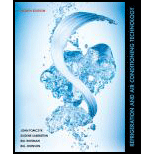
Refrigeration and Air Conditioning Technology (MindTap Course List)
8th Edition
ISBN: 9781305578296
Author: John Tomczyk, Eugene Silberstein, Bill Whitman, Bill Johnson
Publisher: Cengage Learning
expand_more
expand_more
format_list_bulleted
Textbook Question
Chapter 40, Problem 10RQ
The seasonal energy efficiency ratio (SEER) includes the energy used in the _____and _____cycles.
Expert Solution & Answer
Trending nowThis is a popular solution!

Students have asked these similar questions
Copyright 2013 Pearson Education, publishing as Prentice Hall
2. Determine the force that the jaws J of the metal cutters exert on the smooth cable C if 100-N
forces are applied to the handles. The jaws are pinned at E and A, and D and B. There is also
a pin at F.
E
400 mm
15°
D
B
30 mm² 80 mm/
20 mm
15°
$15°
20 mm
400 mm
15°
100 N
100 N
15°
Draw for it make a match which direction
Q.1) Block A is connected to block B by a pulley
system as shown. The weights of blocks A and B
are 100 lbs and 70 lbs, respectively. Assume
negligible friction between the rope and all pulleys
as well as between block B and the incline and
neglect the mass of all pulleys and cables.
Determine the angle 0 required to keep the system
in equilibrium. (At least two FBDs must be drawn
for full credit)
B
Ꮎ
000
Chapter 40 Solutions
Refrigeration and Air Conditioning Technology (MindTap Course List)
Ch. 40 - The standard design conditions for...Ch. 40 - The typical temperature relationship between a...Ch. 40 - The evaporator will normally operate at a(n)...Ch. 40 - A typical temperature relationship between a...Ch. 40 - How is condenser high efficiency obtained?Ch. 40 - High-efficiency air-conditioning systems may use...Ch. 40 - What does the head pressure do If the suction...Ch. 40 - What will cause the suction pressure to rise?Ch. 40 - The evaporator design temperature may in some...Ch. 40 - The seasonal energy efficiency ratio (SEER)...
Knowledge Booster
Learn more about
Need a deep-dive on the concept behind this application? Look no further. Learn more about this topic, mechanical-engineering and related others by exploring similar questions and additional content below.Similar questions
- pls solvearrow_forward+1. 0,63 fin r= 0.051 P The stepped rod in sketch is subjected to a tensile force that varies between 4000 and 7000 lb. The rod has a machined surface finish everywhere except the shoulder area, where a grinding operation has been performed to improve the fatigue resistance of the rod. Using a 99% probability of survival, determine the safety factor for infinite life if the rod is made of AISI 1080 steel, quenched and tempered at 800°c Use the Goodman line. Does the part fail at the fillet? Explainarrow_forwardSolve this problem and show all of the workarrow_forward
- I need drawing solution,draw each one by one no Aiarrow_forwardQu. 17 Compute linear density values for [100] for silver (Ag). Express your answer in nm''. . Round off the answer to three significant figures. Qu. 18 Compute linear density value for [111] direction for silver (Ag). Express your answer in nm'. Round off the answer to three significant figures. Qu. 19 Compute planar density value for (100) plane for chromium (Cr). Express your answer in nm?. Round off the answer to two significant figures. Qu. 20 Compute planar density value for (110) plane for chromium (Cr). Express your answer in nm ≥ to four significant figures. show all work please in material engineeringarrow_forward3-142arrow_forward
- I need solutionsarrow_forward3-137arrow_forwardLarge wind turbines with a power capacity of 8 MW and blade span diameters of over 160 m areavailable for electric power generation. Consider a wind turbine with a blade span diameter of 120m installed at a site subjected to steady winds at 8.25 m/s. Taking the overall efficiency of thewind turbine to be 33 percent and the air density to be 1.25 kg/m3, determine the electric powergenerated by this wind turbine. Also, assuming steady winds of 8.25 m/s during a 24-h period,determine the amount of electric energy and the revenue generated per day for a unit price of$0.08/kWh for electricity.arrow_forward
arrow_back_ios
SEE MORE QUESTIONS
arrow_forward_ios
Recommended textbooks for you
 Refrigeration and Air Conditioning Technology (Mi...Mechanical EngineeringISBN:9781305578296Author:John Tomczyk, Eugene Silberstein, Bill Whitman, Bill JohnsonPublisher:Cengage Learning
Refrigeration and Air Conditioning Technology (Mi...Mechanical EngineeringISBN:9781305578296Author:John Tomczyk, Eugene Silberstein, Bill Whitman, Bill JohnsonPublisher:Cengage Learning

Refrigeration and Air Conditioning Technology (Mi...
Mechanical Engineering
ISBN:9781305578296
Author:John Tomczyk, Eugene Silberstein, Bill Whitman, Bill Johnson
Publisher:Cengage Learning
The Refrigeration Cycle Explained - The Four Major Components; Author: HVAC Know It All;https://www.youtube.com/watch?v=zfciSvOZDUY;License: Standard YouTube License, CC-BY